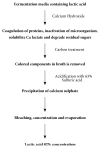Metabolic Engineered Biocatalyst: A Solution for PLA Based Problems
- PMID: 30302092
- PMCID: PMC6158955
- DOI: 10.1155/2018/1963024
Metabolic Engineered Biocatalyst: A Solution for PLA Based Problems
Abstract
Polylactic acid (PLA) is a biodegradable thermoplastic polyester. In 2010, PLA became the second highest consumed bioplastic in the world due to its wide application. Conventionally, PLA is produced by direct condensation of lactic acid monomer and ring opening polymerization of lactide, resulting in lower molecular weight and lesser strength of polymer. Furthermore, conventional methods of PLA production require a catalyst which makes it inappropriate for biomedical applications. Newer method utilizes metabolic engineering of microorganism for direct production of PLA through fermentation which produces good quality and high molecular weight and yield as compared to conventional methods. PLA is used as decomposing packaging material, sheet casting, medical implants in the form of screw, plate, and rod pin, etc. The main focus of the review is to highlight the synthesis of PLA by various polymerization methods that mainly include metabolic engineering fermentation as well as salient biomedical applications of PLA.
Figures





Similar articles
-
A review of exploring the synthesis, properties, and diverse applications of poly lactic acid with a focus on food packaging application.Int J Biol Macromol. 2024 Dec;283(Pt 4):137905. doi: 10.1016/j.ijbiomac.2024.137905. Epub 2024 Nov 20. Int J Biol Macromol. 2024. PMID: 39577526 Review.
-
Green Copolymers Based on Poly(Lactic Acid)-Short Review.Materials (Basel). 2021 Sep 13;14(18):5254. doi: 10.3390/ma14185254. Materials (Basel). 2021. PMID: 34576477 Free PMC article. Review.
-
A review on biodegradable polylactic acid (PLA) production from fermentative food waste - Its applications and degradation.Int J Biol Macromol. 2023 Apr 15;234:123703. doi: 10.1016/j.ijbiomac.2023.123703. Epub 2023 Feb 16. Int J Biol Macromol. 2023. PMID: 36801291 Review.
-
Polylactic acid: synthesis and biomedical applications.J Appl Microbiol. 2019 Dec;127(6):1612-1626. doi: 10.1111/jam.14290. Epub 2019 Jun 17. J Appl Microbiol. 2019. PMID: 31021482 Review.
-
Poly(lactic acid)-Mass production, processing, industrial applications, and end of life.Adv Drug Deliv Rev. 2016 Dec 15;107:333-366. doi: 10.1016/j.addr.2016.03.010. Epub 2016 Apr 1. Adv Drug Deliv Rev. 2016. PMID: 27046295 Review.
Cited by
-
Exploring the Role of Green Microbes in Sustainable Bioproduction of Biodegradable Polymers.Polymers (Basel). 2023 Dec 4;15(23):4617. doi: 10.3390/polym15234617. Polymers (Basel). 2023. PMID: 38232039 Free PMC article. Review.
-
Biomedical Applications of Bacteria-Derived Polymers.Polymers (Basel). 2021 Mar 29;13(7):1081. doi: 10.3390/polym13071081. Polymers (Basel). 2021. PMID: 33805506 Free PMC article. Review.
-
Microbial Production of Biodegradable Lactate-Based Polymers and Oligomeric Building Blocks From Renewable and Waste Resources.Front Bioeng Biotechnol. 2021 Feb 4;8:618077. doi: 10.3389/fbioe.2020.618077. eCollection 2020. Front Bioeng Biotechnol. 2021. PMID: 33614605 Free PMC article. Review.
-
Implementation of Synthetic Pathways to Foster Microbe-Based Production of Non-Naturally Occurring Carboxylic Acids and Derivatives.J Fungi (Basel). 2021 Nov 29;7(12):1020. doi: 10.3390/jof7121020. J Fungi (Basel). 2021. PMID: 34947002 Free PMC article. Review.
-
The Influence of Surface Modification with Biopolymers on the Structure of Melt-Blown and Spun-Bonded Poly(lactic acid) Nonwovens.Materials (Basel). 2022 Oct 12;15(20):7097. doi: 10.3390/ma15207097. Materials (Basel). 2022. PMID: 36295163 Free PMC article.
References
-
- Henton D. E., Gruber P., Lunt J., Randall J. Polylactic acid technology. Natural Fibers, Biopolymers, and Biocomposites. 2005;16:527–577.
-
- Wee Y.-J., Kim J.-N., Ryu H.-W. Biotechnological production of lactic acid and its recent applications. Food Technology and Biotechnology. 2006;44(2):163–172.
-
- Taskila S., Ojamo H. Lactic Acid Bacteria-R & D for Food, Health And Livestock Purposes. InTech; 2013. The current status and future expectations in industrial production of lactic acid by lactic acid bacteria.
Publication types
LinkOut - more resources
Full Text Sources
Molecular Biology Databases

